This post may contain affiliate links. See our affiliate disclaimer here.
RV camping is one of the best ways to travel and explore America. However, properly caring for an RV requires constant maintenance. RV road trips also require careful planning to select safe routes and find the best places to stay.
Keep reading our complete guide to RVing for Beginners for 44 essential RV camping tips that will keep your family safe and happy on the road.
Contents
- 1 RV Maintenance Tips
- 1.1 Service Water Heaters Annually
- 1.2 Service Air Conditioners Annually
- 1.3 Sanitizing Fresh Water Tanks
- 1.4 Lubricate Holding Tank Handles
- 1.5 Sealing Windows and Doors
- 1.6 Prevent and Remove Mud Daubers
- 1.7 Removing Black Streaks
- 1.8 Prevent Damage when Winterizing
- 1.9 Inspect Entry Stairs
- 1.10 Inspect Plumbing Connections
- 1.11 Maintain RV Batteries
- 1.12 Photograph the Bottom of Slide Outs
- 1.13 Keep It Simple
- 2 Must Have RV Gear
- 3 RV Travel and Driving Tips
- 3.1 Safe Following Distance
- 3.2 Finding RV Friendly Fuel Stations
- 3.3 RV Travel with Pets
- 3.4 Greasing the Hitch Ball
- 3.5 Tire Checks for RV Travel
- 3.6 Changing Travel Trailer and Fifth Wheel Tires
- 3.7 Securing Cabinets for Travel
- 3.8 Know Your RV’s Height
- 3.9 Plan your Route Carefully
- 3.10 Parking with Slide Outs
- 3.11 Manual Jack Overrides
- 4 RV Camping Tips
- 4.1 Troubleshooting Hot Water Issues
- 4.2 Fixing Clogged RV Showers
- 4.3 Fixing Beeping RV Refrigerators
- 4.4 Preventing Condensation
- 4.5 Receiving Mail on the Road
- 4.6 Snow Removal
- 4.7 Photograph Electric Meters
- 4.8 Test RV Toilet Paper
- 4.9 Changing Thermostat Scale
- 4.10 Accessing Clean Drinking Water
- 4.11 Resetting LCI Leveling Systems
- 5 RV Safety Tips
RV Maintenance Tips
Our first RVing for beginners tip is to learn RV maintenance and learn it now! Proper RV maintenance will keep your RV out of the shop and on the road. Follow these tips and tricks to keep your RV in tip top shape.
Service Water Heaters Annually
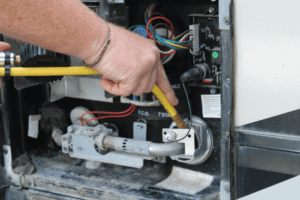
RV water heaters need to be cleaned at least once every year to flush out sediment that has built up and prevent damage. Cleaning your water heater is a simple process that most RV owners should be able to do on their own.
See our guide to maintaining RV water heaters for step by step instructions on how to clean Atwood and Suburban water heaters.
Service Air Conditioners Annually
Rooftop RV AC units also need to be cleaned and serviced annually. Properly maintaining he air conditioner does require climbing onto the roof of your RV.
If you are not comfortable standing on your roof, schedule annual maintenance with a certified RV technician. If you feel comfortable completing the service yourself, see our step by step guide to air conditioner maintenance.
Sanitizing Fresh Water Tanks
RV fresh water tanks also need regular cleaning. These tanks should be sanitized on new RVs before your first trip, before and after long periods of storage and after contamination (i.e. filling with water in Mexico).
To sanitize your fresh water tank, simply empty the tank, fill it back up with a mixture of bleach and potable water, let the solution sit for several hours and thoroughly drain and flush the tank. See our step by step guide to cleaning RV fresh water tanks for more detailed instructions.
Lubricate Holding Tank Handles
The handles for RV black and gray tanks need to be lubricated. If they are not properly lubricated, the handles can stick and your black tank can get stuck in the open position. To prevent sticky handles, lubricate them regularly.
First, empty all of your holding tanks. Then, pull one handle out and spray Teflon lubricant on the metal rod. Slowly pull the lubricated handle in and out a few times. Repeat for the other tanks. Always pull the handles straight out, twisting can damage the connected cables.
Sealing Windows and Doors
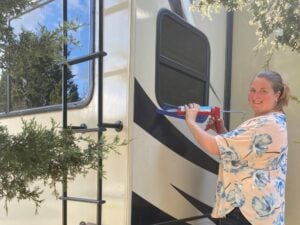
Keeping all of the seals around your RV’s exterior doors, windows and storage bays is critical for preventing water damage. Visually inspect the seals each month. Any spots with cracked, chipped or thinning sealant needs to be re-sealed.
Before applying the sealant, remove the old sealant. Then, place painters tape above and below the sealant line to ensure even lines. Apply the new sealant with a caulk gun and remove the tape after 3 to 5 minutes.
Check the forecast and make sure there is no rain for at least 24 hours so they sealant has time to dry. See our guide to RV sealants for more details.
Prevent and Remove Mud Daubers
Mud Daubers are wasps that build their nests from mud. Unfortunately for RV owners, these wasps like to build their nests in RV appliances. These nests can damage appliances or in the worst case scenario, start a fire.
To prevent mud daubers, put protective screens over openings of appliances such as your hot water heater. After any prolonged period of not using your RV (or specific appliances), visually inspect appliance panels for nests. If mud duaber nests are found, do not turn on the impacted appliance until the nests have been removed.
Removing Black Streaks
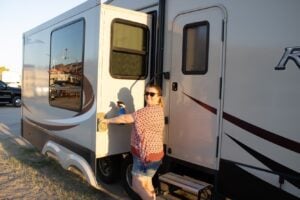
Black streaks on RV exteriors are caused by water from rain or air conditioners running down the surface of the RV. Any dirt or pollutants in the water are left behind and create black streaks on the camper.
The easiest way to prevent black streaks is to keep your roof and AC drain pipes clean, so there is not a lot of dirt in the water running down your RV.
Most black streaks are easily removed with soap and water, but Reliable 1 cleaning solution works great for stubborn black streaks that have been baked in by the sun. Click here for a more detailed guide to removing black streaks.
Prevent Damage when Winterizing
During the winterizing process, the aerator screens in your kitchen and bathroom sink faucets can become clogged with debris from your lines or calcium from the water heater.
To prevent this issue from occurring, remove and clean the aerator screens after winterizing and before de-winterizing. If your kitchen faucet has a spray nozzle, you may need to remove the entire faucet head instead.
Inspect Entry Stairs
Like all things in an RV, entrance stairs need to be routinely inspected. The most common issue with stairs is screws coming loose during bumpy travel days.
Check the screws every month or so to make sure they are secure. Always have extra screws on hand, in case one completely pops out.
Inspect Plumbing Connections
The plumbing line connections in RVs are attached with clamps. These clamps can easily come loose during travel or due to high water pressure. Once a clamp detaches, water will flow out and can cause a major flood.
These fittings should be checked regularly to ensure they are tight and undamaged. Carry extra clamps and a PEX crimping tool in your RV to repair any loose connections. It is always a good idea to turn off your water pump or the city water before leaving your RV.
If a leak happens when you are away from camper, it can turn disastrous quickly. Check out our list of 27 other essential tools every RV owner should have in their tool kit.
Maintain RV Batteries
If your RV has a wet or flooded cell battery, you should be checking the water levels regularly. To check the water levels, remove the caps on the battery cells and make sure the water is high enough to cover any exposed plates.
The water should ideally come to 1/8 of an inch below the split-ring. The split-ring is the plastic ring that extends about 1 inch down into the cell. When adding water to your battery, make sure the battery is fully charged and only use distilled water.
Pay special attention to battery water levels when you are camping in hot weather or dry camping and frequently discharging the battery.
Photograph the Bottom of Slide Outs
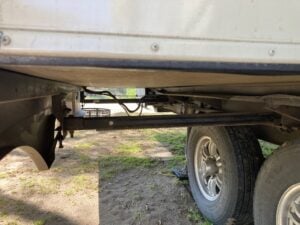
All RV slide outs have wires for their electric power, and some may also contain wires and lines for appliances. However, different manufacturers attach and secure these lines in different ways.
Every RV owner should take pictures under each slide out. Then, when wires become loose or unattached, you will know exactly how to re-secure them.
Keep It Simple
This rule is probably one of the most important tips in our guide to RVing for beginners. When troubleshooting issues in your RV, remember to keep it simple and look for the most obvious solution first.
Many new RVers end up paying a professional to flip a switch because they did not check the obvious culprits before calling for help. For example, if your furnace will not start, first check that the propane tank is turned on and not empty.
Must Have RV Gear
Our next section in the complete guide to RVing for beginners is must have RV gear. These essential RV accessories should be purchased before your first road trip.
Black Tank Camping Gear
There are two awesome pieces of equipment that will making emptying your holding tanks easier and more sanitary. The first item, is an RV gate valve. This valve attaches to your sewer output and has it’s own closure.
Close the door or gate on this valve before disconnecting the sewer hose to prevent leaks and drips. The second piece of gear is a reverse flush valve. This tool is used to shoot water up into the black tank to break up stubborn clogs. Every RVer should own both of these.
Click here to see sanitary ways to store your RV sewer hose and other black tank gear.
Sewer Hose Supports
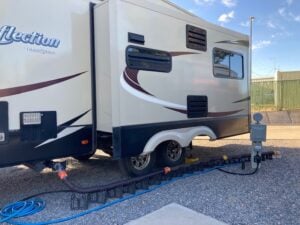
Another important item for proper holding tank cleaning are sewer hose supports. When your RV is connected from the the RV to the dump it is super important that it flows down the whole way to avoid clogs.
Using sewer hose supports is the easiest way to ensure the waste from your RV can drain properly. The sewer hose should never be laid flat on the ground or where it points upward away from the RV.
Surge Protector
Surge protectors are one of the most important pieces of equipment to protect your RV. If you own an RV, and do not have one, go buy it today! Surge protectors should be used every time your plug into shore power.
These devices protect your RV from surges due to lightening or other issues. Newer models also protect your RV from incorrect wiring and electrical issues at campgrounds.
At each new campsite, turn the power off, plug the power cord into your RV and plug the surge protector into your power cord and the campground’s electric box. Then, turn the power on and check the lights on the protector. If the surge protector indicates an issue, turn off the power, unplug and ask the campground for a new site.
Water Pressure Regulator
Another critical piece of RV gear is a water pressure regulator. Water pressure regulators prevent high pressure from damaging delicate RV water lines. A regulator should be use anytime you are connected to city water at a campground.
To use, simply connect the regulator between the city water connection and your hose. Adjust the regulator screw at the top of the device to between 40 and 50 psi. Never let psi exceed 60.
RV Travel and Driving Tips
Our next topic in our complete guide to RVing for beginners is driving, towing and travel days. Note these tips and tricks to keep you safe and happy while driving across the country.
Safe Following Distance
All RV drivers should adhere to a safe following distance, so there is plenty of time to brake if the car in front of you stops suddenly. The general rule of thumb is to allow 1 second of following distance for every 10 feet of vehicle length.
For example, a 20 foot truck pulling a 30 foot trailer should allow a minimum of 5 seconds following distance. To calculate your seconds distance, pick a landmark and count the seconds between the car in front of you and your RV reaching it.
Finding RV Friendly Fuel Stations

Trucker Path is a great app for finding truck stops and truck-friendly gas stations along your route. Download the app before heading out on your first road trip. If you have several choices of filling stations on your trip, look for Flying J gas stations.
All Flying J’s have separate pumps specifically designed for RVs. The RV lanes are easy to navigate and allow you to pay at the pump, unlike many truck stops.
RV Travel with Pets
One of the biggest perks of RV travel is the ability to bring your pets along on the journey. However, there are several important RV camping tips for pets to ensure your fur babies are safe and happy on the road.
Before taking your pet on an RV road trip, take them on a one hour test drive to see if they have any issues with car sickness. If they do get car sick, ask your vet for medication.
While your are on your road trip, the website Bring Fido is a great resource to find pet-friendly activities and restaurants. See our detailed articles for more RV camping tips for dogs and cats.
Greasing the Hitch Ball
Travel trailer and fifth wheel owners should apply a thin layer of grease over the entire ball before hitching up their RV. To avoid getting grease on your hands, use a paint brush to apply it.
To prevent grease from getting on other things and to protect the ball, cut an X into a tennis ball and place it over the hitch ball while parked.
Tire Checks for RV Travel
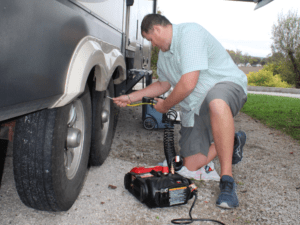
Always check tire pressure before hitting the road in your RV. The recommended tire pressure is noted on the sidewall of your tires. Traveling with an air compressor is ideal, so tire pressure can be adjusted before driving.
After removing or replacing a tire, the lug nuts must be torqued. Torque the lug nuts both when the new tire is put on and after driving 50 miles. To torque lug nuts, set your torque wrench to the proper foot pounds (check your owner’s manual).
Then, place the socket on the nut and turn the handle until it pops. Always torque in a star pattern, moving diagonally around the tire.
Changing Travel Trailer and Fifth Wheel Tires
While a roadside assistance plan is necessary to help you in case of significant damage, changing a flat or worn tire may be easier (and quicker) to take care of by yourself. The Trailer Aid Tandem Tire Changing Ramp makes this even easier for any trailer with at least two tires on each side.
To use, simply drive the other tire onto the ramp and it will raise the flat tire off the ground so you can change the tire without a jack. Always travel with a spare tire for your trailer, and pull as far off the road as possible before working on it.
Securing Cabinets for Travel
Child safety locks are an ingenious solution for securing RV cabinet doors during travel. When set into the lock position, the locks will latch and secure cabinet doors for travel.
However, they can also be unlocked during camping trips so they are not annoying when you are parked. Click here to see more of the best RV cabinet latches.
Know Your RV’s Height
Every RV owner should know the exact height of their RV in order to know exactly what height overpasses and bridges can be safely cleared. Do not trust the manufacturer’s published height, always measure it yourself.
To ensure accurate measurements, have trailers and fifth wheels hitched up before measuring. Also, make sure the RV is parked on level ground and measure on both sides just in case. Measure the RV from the ground to the highest point on the roof (usually the AC unit).
Plan your Route Carefully
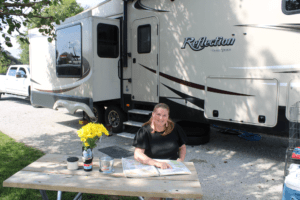
To select the best route for RV travel, use a road carrier’s atlas to identify routes appropriate for larger vehicles. Do not rely solely on navigation apps, which may take you down narrow or winding roads.
However, during travel days, leave the Google Maps app open to alert you to traffic jams or crashes. Kept the atlas on hand, so you can check alternate routes for low clearance bridges before re-routing.
Parking with Slide Outs
Many campgrounds have tight spots that force you to park close to electric poles or trees. For RVs with slide outs, it can be difficult to eyeball if you have enough room for the slide. To avoid parking too close, keep an item on hand that is the same width as your slide so you can easily measure if your slide will fit.
Personally, we use a level that happens to be the same width as our slide, but a simple piece of string also works great. Download our RV setup and departure checklists for more tips on making parking and departure days easy.
Manual Jack Overrides
Electronic jacks all have a manual override that can be used in case of electrical failure. All RV owners should reference their owner’s manual to learn how to access the manual override.
Before your first road trip, practice using the override to avoid having to learn at the same moment things are going wrong. Keep the tools required for the manual override (a ratchet with the proper-size drive extension) easily accessible near your jacks.
RV Camping Tips
The best part of RVing is hanging out at a beautiful campsite. Follow these RVing for beginners tips to troubleshoot and address common RV camping issues.
A simple problem with your RV can easily ruin a relaxing weekend getaway. Bookmark this page, to save these RVing for beginners tips in case you run into similar issues in the future.
Troubleshooting Hot Water Issues
A common issue RVers encounter is to find your cold water faucets working fine, but nothing comes out of the hot water faucet. The most likely issue is the check valve. To confirm that the check valve is the culprit, turn on your hot water bypass (check your owner’s manual for the location).
If water comes out of the hot water faucet while the bypass is turned on, the check valve is the issue. To fix it, simply purchase a new check valve and replace the old one. Check valves are typically located on the backside of RV water heaters.
Click here to see 10 more reasons your RV water heater is not working.
Fixing Clogged RV Showers
If your RV’s shower pan stops draining properly and starts filling with water, you may have a clog. Before addressing the clog, first double-check that your gray water tank is not full. If the gray tank is not full, then your shower drain is clogged. First, remove any obvious debris or hair from the drain.
Then, pour one cup of Dawn detergent down the shower drain. Boil water in your largest pot and pour the water down the shower drain. Repeat with two to three more pots of boiling water.
Let the detergent and water sit in the tank overnight (or at least several hours) before draining the gray tank. Always use a drain cover in your RV shower to prevent these clogs. Never use Drano or similar products in your RV.
Fixing Beeping RV Refrigerators
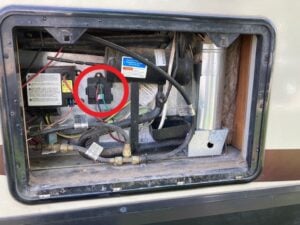
This tip is for Norcold RV refrigerators. If your fridge is beeping and the screen says “L1 Op,” your limit switch (a safety device) has been opened, and the fridge has been shut down. This is typically caused by water getting in the back of your refrigerator while washing the RV or during a heavy storm.
If you are not 100% sure that your exterior refrigerator panel has been exposed to water, then call a professional to ensure you do not have a more serious safety issue. If water is the issue, open the panel, dry everything inside and identify the limit switch (circled in the below picture).
Place a strong magnet just above the red light on the limit switch. After a few seconds, you should hear two clicks, the red light should turn off and the issue should be resolved!
Preventing Condensation
Condensation occurs when warm air inside the RV comes into contact with colder surfaces, such as windows, metal surfaces and walls. The condensation would stop if the air inside the RV matched the outdoor temperature.
When camping in cooler weather, managing condensation should be a priority. To prevent condensation you need to remove moisture from the air using one or more methods. Running a dehumidifier is one effective way to remove condensation.
DampRid buckets are another good option for removing condensation and moisture, especially when dry camping. If these items do not control the condensation effectively, reduce moisture by using a bathhouse for showers and cooking in the oven instead of using the stovetop.
Receiving Mail on the Road
When living in an RV or taking an extended road trip, you will likely need to receive mail or packages. If your campground does not accept mail or you are boondocking, there is an easy solution to receive mail anywhere in the United States.
The US Postal Service offers general delivery as a service for those who are without a permanent mailing address. To ship a package to yourself via general delivery just address the package to Your Name, General Delivery, City, State, Zip Code. See our full blog post, for more information on using general delivery and other mail options for RVers.
Snow Removal
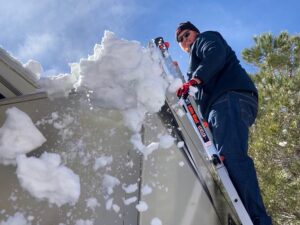
Camping in a winter wonderland is a unique experience, but RVers need to manage snow accumulation on their roof. Any more than a few inches of snow can cause roof damage.
If the snow melts during the day and re-freezes at night, the water expanding as it freezes can turn any small crack or leaks into major points of entry for water. If their is enough accumulation, the weight can also cause damage.
To remove the snow, use a ladder to avoid standing on an icy roof. Use a soft tool, such as a broom or plastic shovel, as sharp objects such as metal shovels may damage your roof. While snow should be removed, RVers should just wait for ice to melt as seams may be damaged while trying to break the ice.
Click here to see more essential tips for RV camping in winter.
Photograph Electric Meters
If you are staying at an RV park where electricity is metered (not included in the nightly rate), there are a few precautions to take to avoid being overcharged. On the day of your arrival, right before you plug in, take a picture of the meter and confirm the rate with the RV park’s office staff.
The average rate varies by state, but is typically between 10 to 20 cents per kWh. Take another picture before checking out and multiply the rate by your usage. Most RV parks are not trying to cheat anyone, but we have had a campground accidentally charge us for a previous guest’s usage. The pictures provided proof that we actually owed less money.
Test RV Toilet Paper
RV toilet paper is expensive and not as easy to find as regular brands. However, you need to confirm that regular toilet paper is appropriate for RV use. To find toilet paper that will work in an RV without causing clogs, look for thin, one-ply products.
Then, perform a simple test to confirm if it is RV safe. To test toilet paper for RV use, fill a jar with water and place a few sheets of the paper in the water. Shake the jar once or twice (to simulate the flush of an RV toilet). Let the jar site for one hour.
If the toilet paper fully dissolves, it is safe for use in your camper. If large, undissolved pieces remain, do not use the paper in your RV. See our pick for the best RV toilet paper, and once you’ve found the perfect RV toilet paper, check out our guide to the best RV toilets.
Changing Thermostat Scale
If your RV thermostat suddenly shows temperatures in the 20s, you’ve accidentally changed it to show Celsius readings. To change the setting back to Fahrenheit on Dometic units, press the “+” and “-” buttons at the same time.
For Airxcel thermostats, hold the long, rectangular button down until the unit changes back to Fahrenheit.
Click here for more Dometic RV thermostat troubleshooting ideas.
Accessing Clean Drinking Water
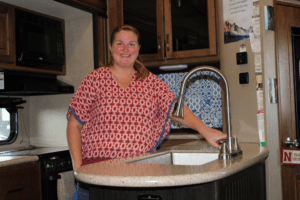
To avoid buying plastic water bottles while traveling, RVers should purchase a water filter. We recommend the Travel Berkey for clean drinking water as it is the most effective RV filtration system. Because it is a gravity-fed system, the Travel Berkey can also be used while boondocking. See our complete list of the best RV water filters for more options.
If you are staying at a campground where they do not recommend drinking the water, locate a water refill station instead of buying plastic bottles for drinking. Click here for more eco-friendly RV camping tips.
Resetting LCI Leveling Systems
Many modern RVs come with LCI electronic leveling systems, which make leveling your RV a breeze. However, many RV campers will encounter error messages with their leveling system.
If you frequently receive errors, you need to reset the system. The exact process for resetting varies by model, but instructions can be found in the LippertNOW app or by calling their amazing customer service team.
RV Safety Tips
Our final section in the ultimate guide to RVing for beginners is safety tips. These important rules will help keep your safe while camping and traveling.
Checking Spare Tires
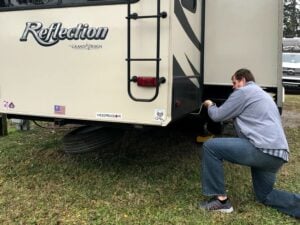
Too many RVers know from firsthand experience that tire blowouts are a common occurrence. Therefore, it is important to always carry an accessible spare tire on your rig. Before travel, locate your spare tire and practice getting it off the RV.
The tire should be a full-size trailer or RV tire and match your current tires. A “donut” tire is not safe for travel and will not get your RV very far in case of a blowout or flat. Also inspect your spare tires every 5000 miles to check for low pressure or cracking.
Transport Propane with Care
If your RV or travel trailer has portable, refillable propane tanks, the tanks need to be transported with care. Always leave the tanks upright, and never lay them on their side.
Secure the propane tanks with bungee cords or straps to ensure they stay still and upright. Always keep the tanks in a well ventilated space, such as a truck bed or a backseat with the windows down. Never put propane tanks in a hot vehicle or a trunk.
Locate Nearby Emergency Services
On the day you arrive at a new campground, use your phone to search for the closest emergency services. Locate the nearest hospital and emergency veterinarian and write down their name, phone number and address.
While you hope emergencies do not happen while camping, it is always better to be prepared. Also ask the campground office where the nearest storm shelter is located in the event of a tornado or other dangerous weather.
Finally, go ahead and locate the best local mobile RV service tech nearby in case your RV has any issues.
Test for Propane Leaks
If you smell a foul odor, and suspect a propane leak, there is an easy bubble test to confirm if a leak is present. To perform the bubble test, mix dish soap and water.
Then, apply the solution to the propane fittings, one at a time, and slowly open the tank. If bubbles appear after a few seconds, propane is leaking out. If a leak is found, turn off the propane immediately.
Replace the leaking connection or hire a professional to fix the issue. Propane leaks can be very dangerous. If you suspect a leak and are not 100% sure what to do, it is always best to call a professional.
Checking Safety Device Dates
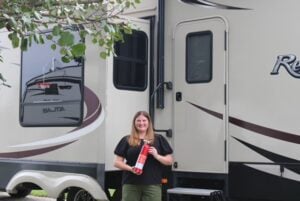
All RVs should have both a fire extinguisher and a gas detector. RVs come with one of two types of fire extinguishers, rechargeable and disposable. If your fire extinguisher has a dial with “recharge” and “overcharge” sections, it is rechargeable.
Rechargeable extinguishers should be serviced every six years. Check with the local fire department to see if they offer this service. Disposable fire extinguishers have a dial that reads either “full” or “empty.” The fire extinguisher needs to be replaced if the dial is pointing to empty.
RV gas detectors typically have a lifespan of about five years. If you have a used RV and do not know when the detector was installed, the production date is printed on the back. It is best to always have a replacement detector on hand, so a new one can be installed as soon as the old one malfunctions.
Don’t worry if you are a new RV owner and having trouble keeping all of these RVing for beginners tips straight. There is definitely a steep learning curve with RV ownership, but if you take your time both during travel and maintenance, you will be an RV pro before you know it.
Do you have other great RV camping tips to share? Leave them in the comments section below.
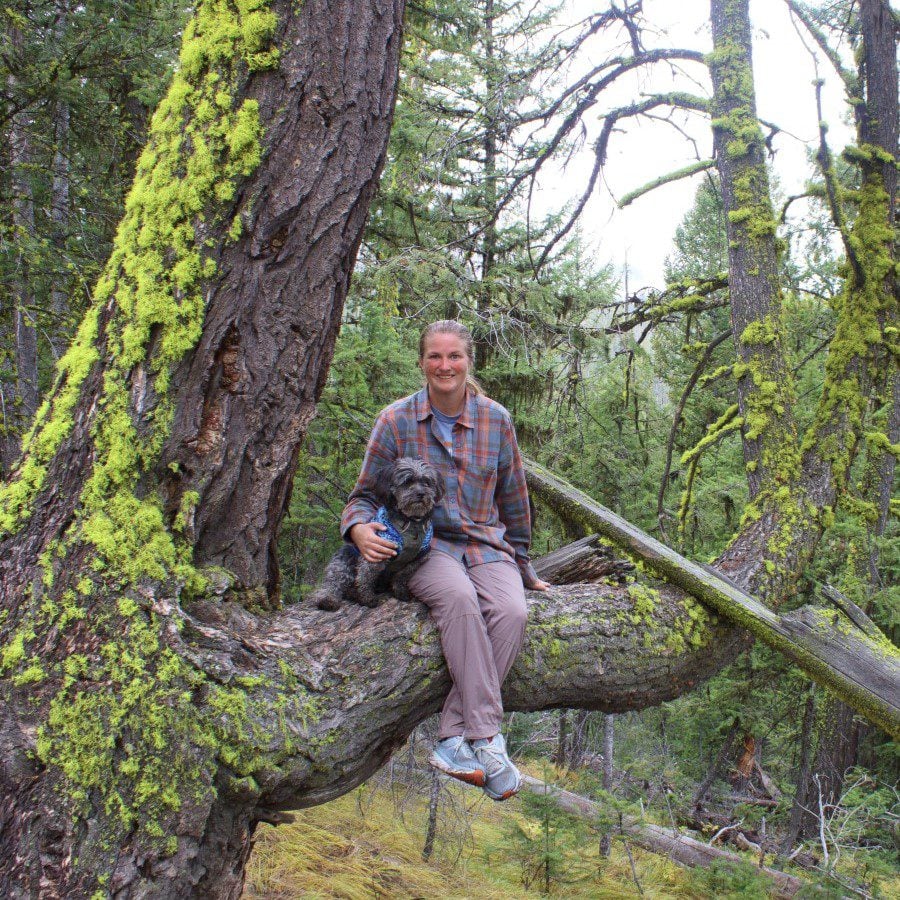
Christina Pate is a seasoned full-time RVer who, along with her husband Justin, has journeyed across the US, Canada, and Mexico. Drawing from her extensive travels, RV repairs and RV renovations, she founded Travels with Ted to guide and inspire fellow RV enthusiasts. Christina is also the co-author of The Owner’s Guide to RV Maintenance and the creator of My RV Log Book.

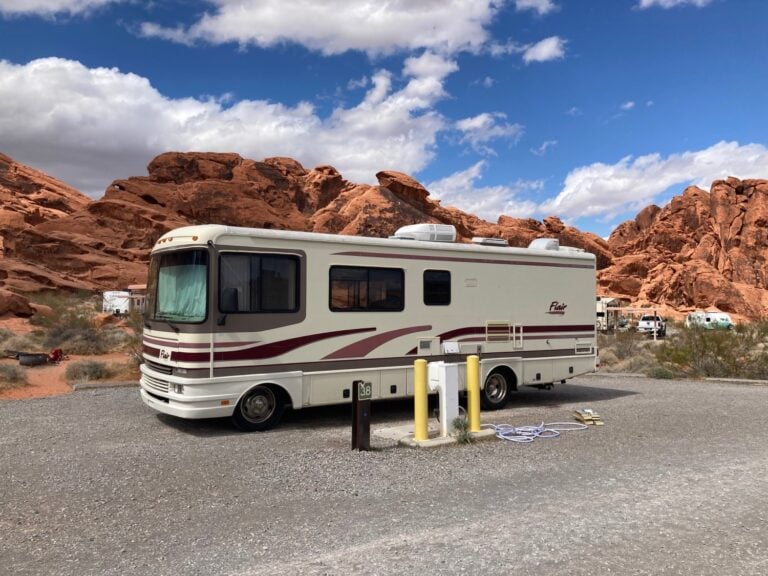
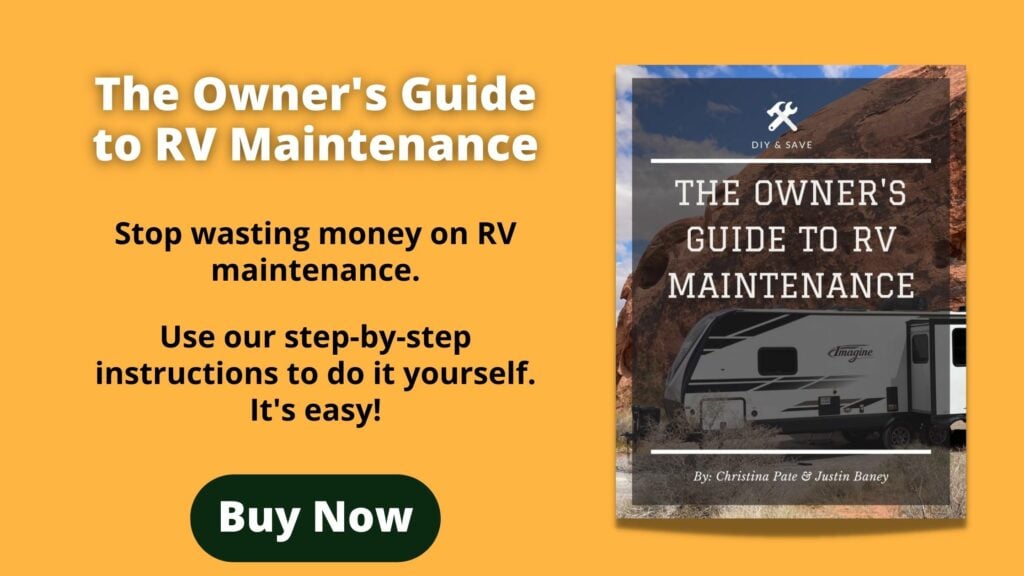
Wow! What a great post! Thank you for sharing all of this helpful information ?
Wow wow wow! This is such a great guide with SO much information I’ll be referring back to this for sure! Thank you!
This is packed full of so much helpful info!! Thanks for sharing all your tips ?
Awesome reminders here! Some of them I hadn’t heard of before. I especially liked the idea of photographing the electric meter for when we get to a place we are going to stay longer term. Thanks so much for sharing!
This is GREAT information!! It will make a good quick reference blog to save! Thank You!!
Wow! What a wealth of information!
This is a really great post! All those little things you need to know that will save you in the long run. Thanks so much for sharing!